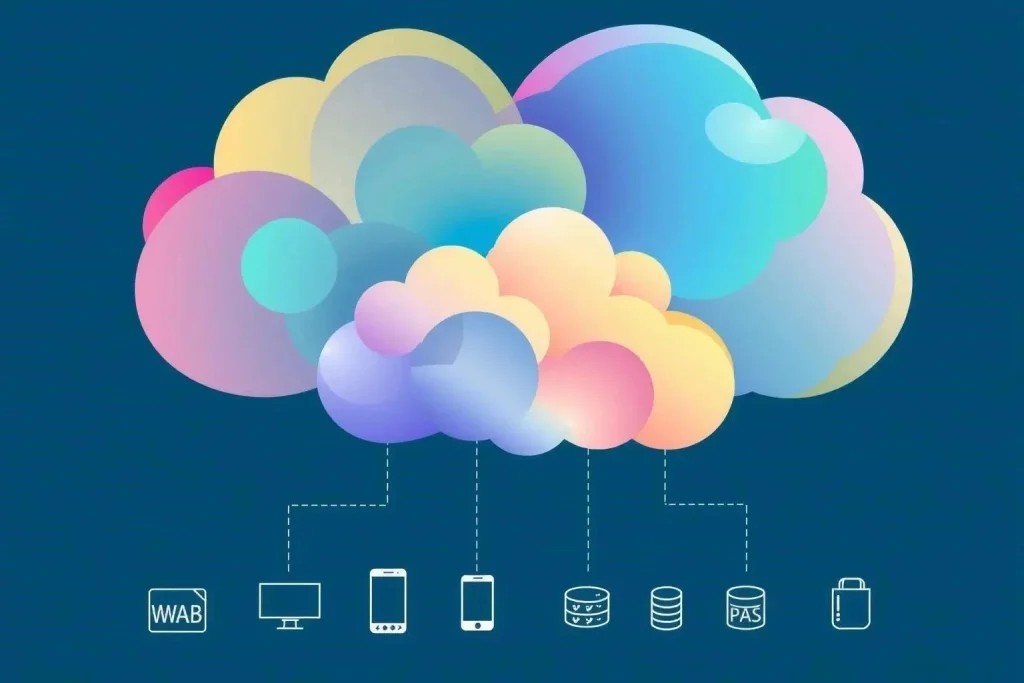Three Incredible Advantages of PaaS for Modern App Development
Struggling with app development? Discover how PaaS slashes costs, boosts agility, and scales your apps like never before. Unlock your app’s potential now!

In today’s rapidly evolving technological landscape, developers are constantly seeking innovative solutions to streamline their app development processes. Platform as a Service (PaaS) has emerged as a powerful contender, offering a comprehensive environment that significantly simplifies and accelerates the creation, deployment, and management of applications. Embracing PaaS can unlock a multitude of benefits, from reduced development costs and increased agility to enhanced scalability and improved collaboration. Let’s explore three incredible advantages that make PaaS an irresistible choice for modern app development.
Advantage 1: Accelerated Development and Deployment
One of the most significant advantages of PaaS is the dramatic acceleration of the development and deployment lifecycle. By providing pre-configured infrastructure, middleware, and development tools, PaaS eliminates the need for developers to spend valuable time on repetitive and time-consuming tasks such as server setup, database configuration, and software updates. This allows developers to focus on what they do best: writing code and creating innovative features.
- Faster Time to Market: Reduced development cycles mean applications can be launched more quickly, giving businesses a competitive edge.
- Simplified Development Process: Pre-built components and tools streamline the development workflow.
- Automated Deployment: PaaS automates the deployment process, reducing errors and ensuring consistent deployments.
Advantage 2: Cost-Effectiveness and Resource Optimization
PaaS offers a compelling value proposition in terms of cost-effectiveness and resource optimization. The pay-as-you-go pricing model allows businesses to only pay for the resources they actually use, eliminating the need for large upfront investments in infrastructure. Furthermore, PaaS providers handle the ongoing maintenance and management of the underlying infrastructure, reducing the burden on internal IT teams.
- Reduced Infrastructure Costs: Eliminate the need to purchase and maintain expensive hardware.
- Lower Operational Expenses: PaaS providers handle infrastructure management, reducing IT overhead.
- Scalable Resources: Easily scale resources up or down based on demand, optimizing resource utilization.
Improved Resource Allocation
Proper resource allocation is crucial for any project. PaaS offers tools to effectively manage resources, leading to cost savings.
Advantage 3: Enhanced Collaboration and Productivity
PaaS fosters collaboration and productivity by providing a centralized platform where developers, designers, and other stakeholders can work together seamlessly. Shared code repositories, integrated development environments (IDEs), and collaborative debugging tools enable teams to work more efficiently and effectively. This increased collaboration leads to higher quality applications and faster time to market.
Consider these benefits:
- Centralized Development Environment: All team members work within a unified platform.
- Improved Communication: Shared tools and workflows facilitate better communication and coordination.
- Increased Productivity: Streamlined workflows and collaborative tools boost overall productivity.
PaaS vs. IaaS vs. Serverless: A Comparison
| Feature | PaaS | IaaS | Serverless |
|---|---|---|---|
| Infrastructure Management | Managed by provider | Partially managed by user | Fully managed by provider |
| Control Level | Medium | High | Low |
| Cost | Pay-as-you-go | Pay-as-you-go | Pay-per-execution |
| Scalability | Automatic | Manual | Automatic |
FAQ about PaaS
What is PaaS?
PaaS stands for Platform as a Service. It is a cloud computing model that provides developers with a complete platform for developing, running, and managing applications without the complexity of managing the underlying infrastructure.
Is PaaS suitable for all types of applications?
PaaS is well-suited for a wide range of applications, including web applications, mobile backends, and APIs. However, it may not be the best choice for applications that require a high degree of customization or control over the underlying infrastructure.
How secure is PaaS?
PaaS providers typically implement robust security measures to protect the platform and the applications running on it. However, it is important to choose a reputable PaaS provider and to follow security best practices when developing and deploying applications.
What are some popular PaaS providers?
Some popular PaaS providers include AWS Elastic Beanstalk, Google App Engine, Microsoft Azure App Service, and Heroku.
Considerations Before Adopting PaaS
While the advantages of PaaS are compelling, a judicious evaluation of potential drawbacks is crucial before complete adoption. Organizations must meticulously assess their specific requirements, security protocols, and vendor lock-in potential. Furthermore, compatibility with existing systems and the learning curve associated with a new platform necessitate careful planning and resource allocation.
Vendor Lock-in Mitigation
A significant concern associated with PaaS is the potential for vendor lock-in. Migrating applications from one PaaS provider to another can be a complex and costly endeavor. Therefore, organizations should prioritize selecting providers that adhere to open standards and offer robust data portability options. Employing containerization technologies such as Docker can also mitigate this risk by encapsulating applications and their dependencies, facilitating easier migration across different environments.
Security and Compliance Adherence
Security remains paramount in any cloud computing deployment. Organizations must diligently evaluate the security posture of potential PaaS providers, ensuring compliance with relevant industry regulations and data privacy laws. Robust access control mechanisms, encryption capabilities, and vulnerability management processes are essential. Furthermore, conducting regular security audits and penetration testing is imperative to identify and address potential vulnerabilities.
Future Trends in PaaS
The PaaS landscape is continuously evolving, driven by advancements in containerization, microservices architecture, and artificial intelligence. Several key trends are poised to shape the future of PaaS, further enhancing its capabilities and expanding its applicability.
- Serverless PaaS: The convergence of PaaS and serverless computing promises to provide even greater scalability and cost optimization. Developers can focus solely on writing code, without the need to manage servers or infrastructure.
- AI-Powered PaaS: Integration of AI and machine learning capabilities into PaaS platforms will enable intelligent automation of various development tasks, such as code analysis, testing, and deployment.
- Low-Code/No-Code PaaS: These platforms empower citizen developers to create applications with minimal coding, democratizing software development and accelerating digital transformation.
The Rise of Specialized PaaS
We are witnessing the emergence of specialized PaaS offerings tailored to specific industries and application domains. These platforms provide pre-built components, tools, and frameworks optimized for specific use cases, such as IoT, data analytics, and machine learning.
The advantages of PaaS are undeniable. From accelerating development cycles and optimizing resource utilization to fostering collaboration and enabling innovation, PaaS empowers organizations to build and deploy applications more efficiently and effectively. While careful consideration of potential challenges such as vendor lock-in and security risks is essential, the strategic benefits of PaaS make it a compelling choice for organizations seeking to thrive in the digital age. By embracing PaaS, businesses can unlock new levels of agility, scalability, and competitiveness, positioning themselves for long-term success in an increasingly dynamic and demanding market.
Beyond the Core: Advanced PaaS Capabilities
The fundamental benefits of PaaS are well-established, however, a deeper exploration reveals more nuanced advantages. Beyond simplified infrastructure management and expedited development cycles, PaaS offerings often include advanced capabilities that significantly enhance the application lifecycle and operational efficiency. These features warrant careful consideration when evaluating PaaS solutions.
- Automated Scaling and Resource Management: PaaS platforms excel at dynamically allocating resources based on application demand. This automated scaling ensures optimal performance, even during peak loads, while minimizing resource wastage during periods of low activity. The platform automatically adjusts compute, storage, and network resources to meet evolving requirements.
- Integrated Monitoring and Logging: Comprehensive monitoring and logging tools are typically integrated into PaaS environments. These tools provide real-time insights into application performance, resource utilization, and potential issues. Proactive monitoring enables rapid identification and resolution of problems, minimizing downtime and ensuring a seamless user experience. Log aggregation and analysis capabilities facilitate debugging and troubleshooting.
- Continuous Integration and Continuous Delivery (CI/CD): PaaS platforms often support CI/CD pipelines, automating the process of building, testing, and deploying applications. This automation streamlines the development workflow, reduces the risk of errors, and accelerates the release cycle. Integrated CI/CD tools enable developers to rapidly iterate and deploy updates with confidence.
Enhancing Security Posture with PaaS
While security concerns are often cited as a potential drawback of cloud adoption, a well-configured PaaS environment can actually enhance an organization’s overall security posture. PaaS providers typically invest heavily in security infrastructure and expertise, offering a level of protection that many organizations struggle to achieve on their own. Furthermore, PaaS platforms often incorporate security best practices and automated security checks.
Key security features of PaaS environments include:
- Identity and Access Management (IAM): Robust IAM controls enable granular control over access to resources and data. Role-based access control (RBAC) allows administrators to define specific permissions for different users and groups, ensuring that only authorized personnel have access to sensitive information.
- Data Encryption: PaaS providers typically offer encryption at rest and in transit, protecting data from unauthorized access. Encryption keys are securely managed to prevent compromise;
- Vulnerability Scanning and Patch Management: Automated vulnerability scanning identifies potential security weaknesses in the application and underlying infrastructure. PaaS providers typically offer automated patch management to ensure that systems are up-to-date with the latest security fixes.
The Economic Impact of PaaS Adoption
Beyond the technical advantages, PaaS adoption can have a significant positive impact on an organization’s bottom line. By streamlining development processes, reducing infrastructure management overhead, and optimizing resource utilization, PaaS can lead to substantial cost savings. Furthermore, PaaS can enable faster time to market, allowing organizations to capitalize on new opportunities and gain a competitive advantage.
Quantifying the Return on Investment (ROI)
Calculating the ROI of PaaS adoption requires a comprehensive analysis of both direct and indirect costs and benefits. Direct costs include the PaaS subscription fees, while indirect costs may include training, migration efforts, and potential vendor lock-in. Benefits include reduced infrastructure costs, increased developer productivity, faster time to market, and improved application reliability.
By carefully quantifying these factors, organizations can gain a clear understanding of the economic impact of PaaS adoption and make informed decisions about their cloud strategy.
Comparative Analysis: IaaS, PaaS, and SaaS
To further contextualize the value proposition of PaaS, it is instructive to compare it with other prominent cloud computing models: Infrastructure as a Service (IaaS) and Software as a Service (SaaS). These models represent different levels of abstraction and control, each catering to distinct organizational needs and priorities.
| Parameter | Infrastructure as a Service (IaaS) | Platform as a Service (PaaS) | Software as a Service (SaaS) |
|---|---|---|---|
| Control Level | Highest; manages OS, middleware, runtime, data, and applications. | Medium; manages data and applications; provider manages OS, middleware, and runtime. | Lowest; provider manages everything. |
| Management Responsibility | Organization manages most aspects. | Shared responsibility; provider manages infrastructure, organization manages application. | Provider manages all aspects. |
| Use Cases | Infrastructure for testing and development, storage, backup, and recovery. | Application development, deployment, and management. | CRM, email, office productivity tools. |
| Scalability | Highly scalable, but requires manual configuration. | Scalable, with automated resource allocation. | Scalable, managed by the provider. |
| Cost | Pay-as-you-go for infrastructure resources. | Pay-as-you-go for platform services. | Subscription-based. |
| Customization | Highly customizable. | Customizable within platform limitations. | Limited customization. |
FAQ: Frequently Asked Questions About PaaS
This section addresses common inquiries regarding Platform as a Service, providing concise and informative answers to facilitate a deeper understanding of its capabilities and limitations.
What types of applications are best suited for PaaS?
PaaS is particularly well-suited for web applications, mobile backends, APIs, and microservices. It excels in scenarios requiring rapid development, deployment, and scaling. Applications requiring highly customized infrastructure or operating systems might be better suited for IaaS.
How does PaaS handle security?
PaaS providers implement robust security measures, including firewalls, intrusion detection systems, and data encryption. However, organizations remain responsible for securing their applications and data within the PaaS environment. It is crucial to implement strong authentication, authorization, and data protection policies.
What are the potential drawbacks of using PaaS?
Potential drawbacks include vendor lock-in, limited control over the underlying infrastructure, and potential security concerns. Careful consideration of vendor selection, data portability, and security policies is essential to mitigate these risks.
How do I choose the right PaaS provider?
Selecting the right PaaS provider requires a thorough assessment of your organization’s specific needs and requirements. Factors to consider include the supported programming languages and frameworks, scalability options, security features, cost, and level of support.
Can I migrate existing applications to PaaS?
Yes, it is possible to migrate existing applications to PaaS, although the process may require some code refactoring and configuration changes. Containerization technologies such as Docker can facilitate the migration process.
What is the future of PaaS?
The future of PaaS is characterized by increasing automation, integration with emerging technologies such as AI and serverless computing, and the rise of specialized PaaS offerings tailored to specific industries and application domains. PaaS is poised to play an increasingly critical role in enabling digital transformation and fostering innovation.




